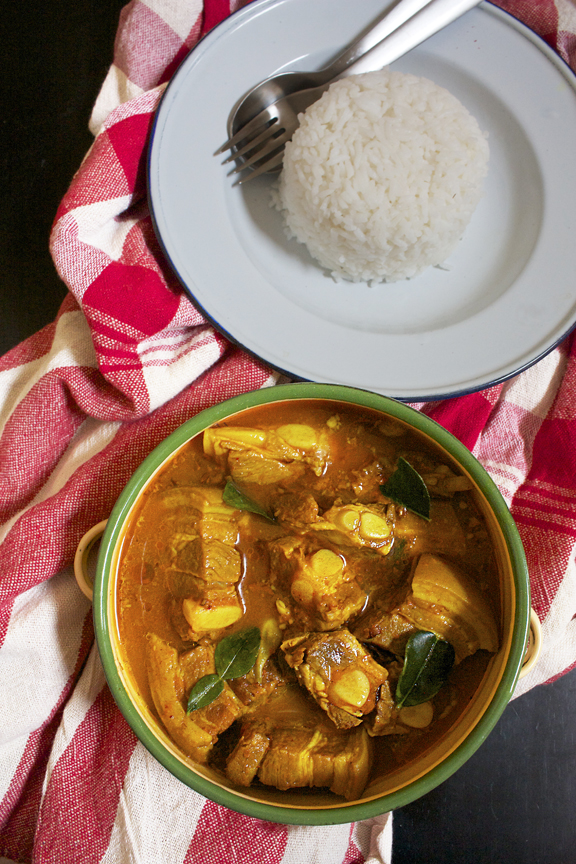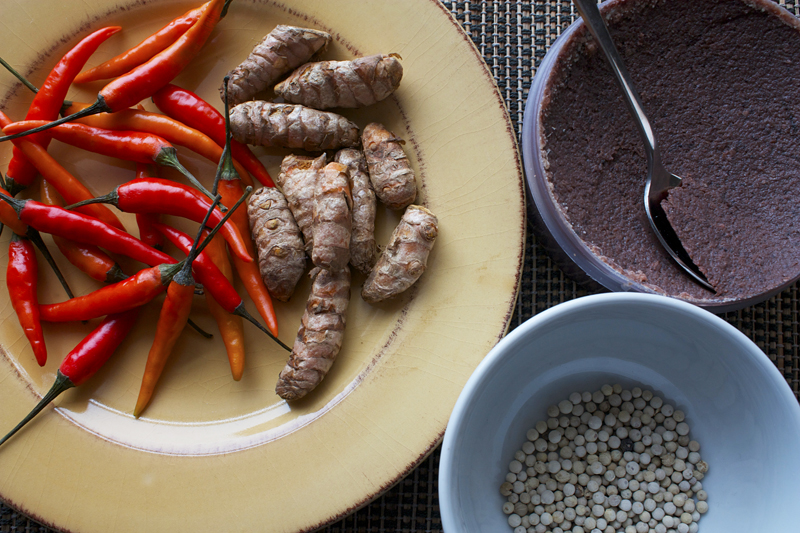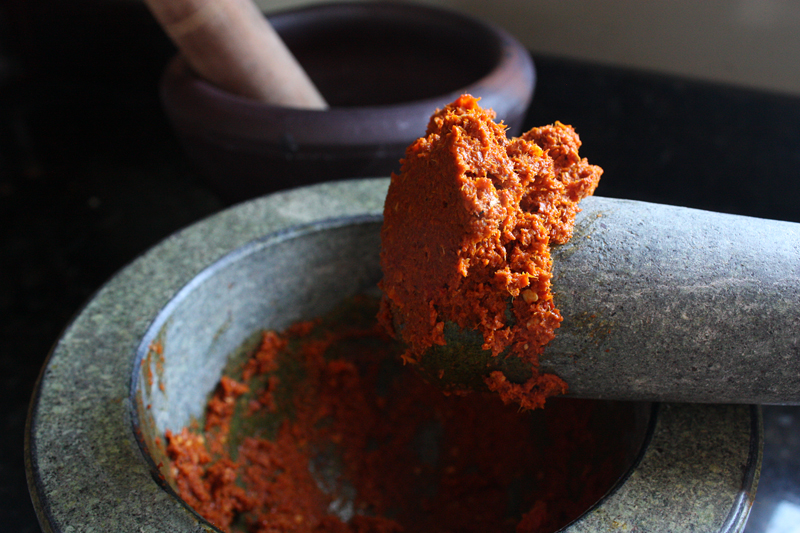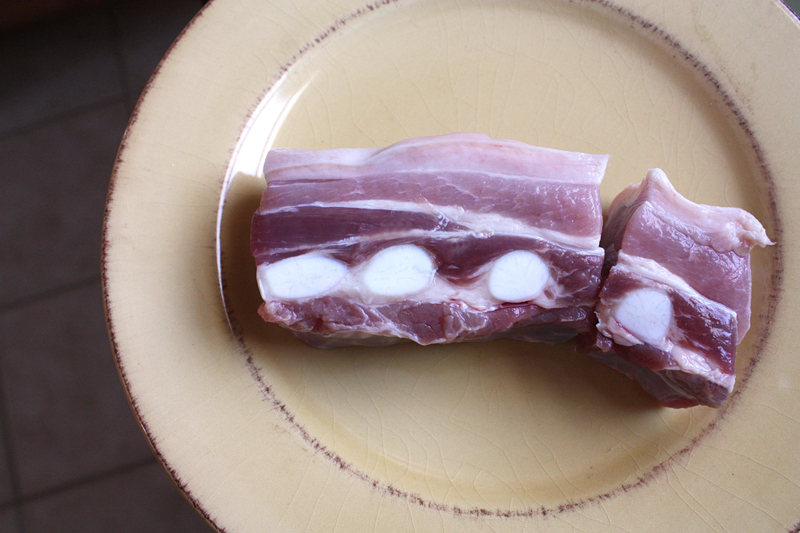
The assumption is often that Thai curries are spicy dishes with thick, creamy coconut-based curry sauce – so much so that questions along the lines of, “How could you possibly call that a curry?” always come up whenever I introduce any dish the Thai recognize as a “curry” that happens to contain no coconut milk. The central sour curry comes to mind; the southern sour curry as well. Then there’s a central version of the so-called “jungle curry” I’ve included in Simple Thai Food that, as far as the Thais are concerned, is a full-fledged curry even though it has absolutely no coconut.
This southern Thai curry is another one. It’s a pretty common dish from the south of Thailand where the food is often painted in broad strokes as liberally seasoned with turmeric and spicy hot. Well, it’s not correct to say that all, or even most, southern dishes contain turmeric. But many do, and this one does. It’s not accurate, either, to say that all or most southern Thai dishes are, or are supposed to be, spicy hot, because I can give you a long list of those that aren’t. Then again, they sometimes are. And, in this region, when they are, they never half-heartedly are, timidly are, or mildly are; they enthusiastically are, audaciously are, and exceedingly are. They so are you can’t help but notice that they are. And among those that are, this one is.
(Sigh) English is hard.

All I’m trying to say is that this coconutless southern Thai curry happens to fit the stereotype; it has turmeric, and it is traditionally made to be very spicy hot. In other words, leave the turmeric out and you end up with something unrecognizable to the southerners; make it anything less than very spicy hot, and you have zero chance of getting a nod of approval from a native of the south. I use quite a lot of fresh red Thai bird’s eye chilies in the paste to achieve the level of heat I associate with the traditional flavor [that would be a 15 on a scale of 1 (baby-approved) to 10 (kill me now)]. This means there could be some serious sweating and, in some cases, weeping and gnashing of teeth. But I wouldn’t have it any other way.
Having said that, since we’re cooking for ourselves here, you don’t have to go that route; you can adjust the heat according to your comfort level. In this cheater’s version, I have you start out with prepared red curry paste (and doctor it up with additional ingredients), and you may find that the paste already provides enough heat for your taste and that you don’t need the additional fresh chilies, after all. That’s fine, too. The curry will be much milder than it usually is in its natural habitat, but I wouldn’t worry about it unless I plan to serve it in a restaurant that promises ‘authentic’ southern Thai food.
But if you’re into heat, go nuts. Use all 30 bird’s eye chilies as I’ve suggested — or more (the heat dissipates greatly after the chilies are cooked). You can also experiment with other types of chili peppers, but you need to go by your own judgment on what and how much to use. Consulting the Scoville scale should help some. Regardless, try to stick with ones that are red, yellow, or orange in color, because green-colored peppers don’t work so well here both in terms of taste and appearance.

But before I get myself misunderstood, let’s be clear on one thing: when it comes to Thai food in general, a high level of heat is not a mark of quality. There are many other things you look for that are more important than, or as important as, heat. The savory taste is chief among them. And in this case, we’ve got plenty of it. The curry paste already has some umami-loaded shrimp paste in it, but that’s not enough for the southern standard; so we add more. However, the main source of savory flavor –the star– is the cut of meat we’ve chosen for this version of kaeng phrik: pork rib tips.
That would be the parts of pork ribs that come with cartilage (as seen here). Any cut of meat that comes with larger bones or cartilage requires long cooking time, but it gives you the deep savory flavor that a skinless, boneless, quick-cooking cut of meat can’t. True, cartilage may not perform as well as bones when it comes to imparting flavor to a liquid dish like this. But, unlike bones, tenderized cartilage can be eaten. You buy, say, a pound of bone-in meat, you end up eating only half of that as the rest gets thrown out. But in the case of meat with cartilage and no bones, you buy one pound, you can eat all of it. Let the frugal cooks, like me, rejoice and be glad in cartilage.
If you can’t find pork rib tips, use baby back ribs and have your butcher halve them crosswise for you. In that case, you want to use 3 pounds, instead of 2 1/2 as the recipe indicates, because some of the weight of the baby back ribs comes from the bones which you don’t eat. Or you can use, as I do here, pork belly that comes with the cartilage-heavy parts of the ribs. Boneless country ribs would be nice as well, though it’s not my preferred choice. If you can’t eat or don’t like pork, bone-in, skin-on chicken will do (consult this post on the rustic version of tom kha).
_________________________________________
PRODUCTS THAT HELP YOU CREATE THIS RECIPE
- 2 heaping tablespoons red curry paste
- 6 pieces of fresh turmeric (each measuring about one inch long), or 1½ tablespoons ground turmeric (Not nearly good as fresh in this recipe, but it will do.)
- 30 (not a typo) fresh, preferably red, Thai bird's eye chilies (See post for more information.)
- 2 teaspoons Thai shrimp paste
- 2 teaspoons whole white or black peppercorns
- 2.5 pounds rib tips (See post for comments and suggested alternatives.)
- 2 teaspoons salt or to taste
- 2 teaspoon palm sugar or 1 teaspoon brown sugar
- 3-4 fresh kaffir lime leaves, torn and bruised (optional)
- Make a smooth paste out of the first five ingredients using a granite mortar. Alternatively, since, in this particular case, you're going to be dissolving the paste in water anyway, you can also put all the paste ingredients in a blender, along with just enough water to get the blades going, and puree until smooth.
- Cut the rib tips into 3-inch cubes and put them in a half-gallon saucepan. Add the prepared paste to the saucepan along with one teaspoon of salt, the sugar, and just enough water to cover the ribs. The level of the water should come up about half an inch above the meat.
- Cover the saucepan and bring the mixture to a boil over medium-high heat. Turn the heat to medium-low to keep the water bubbling only gently and continue to cook, covered, for another 45 minutes after that point (use your own judgment in terms of cooking time, if you use a different cut of meat from what the recipe calls for). Every 15 minutes or so, you will need to check on the water level to make sure that it's always half an inch above the pork. Since the saucepan is covered for the entire duration of the cooking, not much water should evaporate (plus you get some moisture that is released from the meat). But if necessary, replenish the water to maintain the original level and adjust the heat as needed to maintain the gentle simmer. If you use pork belly, you can remove some of the excess fat that rises to the top -- or not; you call.
- After 45 minutes have passed, check on the liquid level; at the end of the cooking process you want it to be the same as when you first started. So if there's too much, remove the lid for better evaporation and reduce it until it reaches the original level. If there's too little, add more water and heat the whole thing through. By this time the meat should already be tender. Taste the curry broth to see if it needs the remaining one teaspoon of salt, keeping in mind that you'll be serving the curry with bland rice. When that's done, stir in the kaffir lime leaves and take the pot off the heat.
- Serve with cooked jasmine rice and fresh vegetables on the side. Thick slices of cucumber go particularly well with this.












[…] tart, and vibrant or something fiery (I recommend southern sour curry with pineapple and shrimp, southern pork rib curry, or scallop-orange-cucumber […]